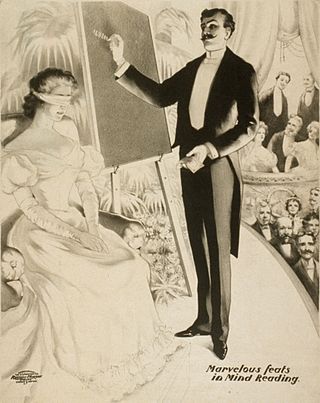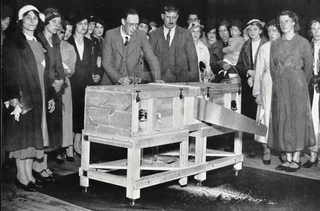
The Balducci levitation is a levitation illusion first described by Ed Balducci. Its inventor is unknown. It is an impromptu magic trick, which has been popularized by many magicians, such as David Roth, Paul Harris, and David Blaine.

The cups and balls is a performance of magic with innumerable adaptations. Street gambling variations performed by conmen were known as Bunco Booths. A typical cups and balls routine includes many of the most fundamental effects of magic: the balls can vanish, appear, transpose, reappear and transform. Basic skills, such as misdirection, manual dexterity, sleight of hand, and audience management are also essential to most cups and balls routines. As a result, mastery of the cups and balls is considered by many as the litmus test of a magician's skill with gimmick style tricks. Magician John Mulholland wrote that Harry Houdini had expressed the opinion that no one could be considered an accomplished magician until he had mastered the cups and balls. Professor Hoffman called the cups and balls "the groundwork of all legerdemain".
Sleight of hand refers to fine motor skills when used by performing artists in different art forms to entertain or manipulate. It is closely associated with close-up magic, card magic, card flourishing and stealing. Because of its heavy use and practice by magicians, sleight of hand is often confused as a branch of magic; however, it is a separate genre of entertainment and many artists practice sleight of hand as an independent skill. Sleight of hand pioneers with worldwide acclaim include Dan and Dave, Ricky Jay, Derek DelGaudio, David Copperfield, Yann Frisch, Norbert Ferré, Dai Vernon, Jerry Sadowitz, Cardini, Tony Slydini, Helder Guimarães and Tom Mullica.

Card manipulation, commonly known as card magic, is the branch of magic that deals with creating effects using sleight of hand techniques involving playing cards. Card manipulation is often used in magical performances, especially in close-up, parlor, and street magic. Some of the most recognized names in this field include Dai Vernon, Tony Slydini, Ed Marlo, S.W. Erdnase, Richard Turner, John Scarne, Ricky Jay and René Lavand. Before becoming world-famous for his escapes, Houdini billed himself as "The King of Cards". Among the more well-known card tricks relying on card manipulation are Ambitious Card, and Three-card Monte, a common street hustle also known as Find the Lady.

Coin magic is the manipulating of coins to entertain audiences. Because coins are small, most coin tricks are considered close-up magic or table magic, as the audience must be close to the performer to see the effects. Though stage conjurers generally do not use coin effects, coin magic is sometimes performed onstage using large coins. In a different type of performance setting, a close-up coin magician will use a large video projector so the audience can see the magic on a big screen. Coin magic is generally considered harder to master than other close-up techniques such as card magic, as it requires great skill and grace to perform convincingly, and this requires much practice to acquire.

Burling Hull was an inventive magician, self-styled "the Edison of magic," specializing in mentalism and sleight of hand effects. During the greater part of his life he lived in DeLand, Florida. His aliases and stage names included: "Volta the Great", "The Man with the Radar Mind", "The White Wizard," and "Gideon ('Gid') Dayn."
A trick deck is a deck of playing cards that has been altered in some way to allow magicians to perform certain card tricks where sleight of hand would be too difficult or impractical.

Mentalism is a performing art in which its practitioners, known as mentalists, appear to demonstrate highly developed mental or intuitive abilities. Mentalists perform a theatrical act that includes special effects that may appear to employ psychic or supernatural forces but that are actually achieved by "ordinary conjuring means", natural human abilities, and an in-depth understanding of key principles from human psychology or other behavioral sciences. Performances may appear to include hypnosis, telepathy, clairvoyance, divination, precognition, psychokinesis, mediumship, mind control, memory feats, deduction, and rapid mathematics.
The Ambitious Card, or Elevator Card, is a magic effect in which a playing card seems to return to the top of the deck after being placed elsewhere in the middle of the deck. This is a classic effect in card magic and serves as a study subject for students of magic. It is also known as the "Trick that Fooled Houdini", as Harry Houdini was unable to determine how the trick was done when it was performed for him, multiple times, by Dai Vernon. Most performing card magicians will have developed their own personal Ambitious Card routine.

Sawing a woman in half is a generic name for a number of stage magic tricks in which a person is apparently cut or divided into two or more pieces.

Card marking is the process of altering playing cards in a method only apparent to marker or conspirator, such as by bending or adding visible marks to a card. This allows different methods for card sharps to cheat or for magicians to perform magic tricks. To be effective, the distinguishing mark or marks must be visible on the obverse sides of the cards, which are normally uniform.

The bullet catch is a stage magic illusion in which a magician appears to catch a bullet fired directly at them — often in the mouth, sometimes in the hand or sometimes caught with other items such as a dinner plate. The bullet catch may also be referred to as the bullet trick, defying the bullets or occasionally the gun trick.

Billet reading, or the envelope trick, is a mentalist effect in which a performer pretends to use clairvoyance to read messages on folded papers or inside sealed envelopes. It is a widely performed "standard" of the mentalist craft since the middle of the 19th century. Billet is the French term for note or letter, referring to the rectangular shape of the paper.
This is a glossary of conjuring terms used by magicians.
Penn & Teller's Magic and Mystery Tour is a 2003 television documentary miniseries starring Penn & Teller. The program was created by the CBC in association with Channel 4 Film. Ric Esther Bienstock was series producer and writer. She also directed the China episode.

The Tarbell Course in Magic is a notable encyclopedia of magic amongst professional and amateur magicians. It has eight volumes; the first five were part of the original home-study correspondence course compiled in 1928 by Harlan Tarbell, the remaining three volumes being added on later.

Chink-a-chink is a simple close-up magic coin trick in which a variety of small objects, usually four, appear to magically transport themselves from location to location when covered by the performer's hands, until the items end up gathered together in the same place. Variations, especially the Sympathetic Coins, also known as Coins-n-Cards, have been performed since the 1800s. Popular modern variations are Shadow Coins and Matrix. A variation using playing cards as the objects is known as Sympathetic Aces.

Magic, which encompasses the subgenres of illusion, stage magic, and close-up magic, among others, is a performing art in which audiences are entertained by tricks, effects, or illusions of seemingly impossible feats, using natural means. It is to be distinguished from paranormal magic which are effects claimed to be created through supernatural means. It is one of the oldest performing arts in the world.
The book test is a classic mentalism demonstration used by mentalists to demonstrate telepathy-like effects. The name refers to its early use as a test of mental powers.

The art form of card flourishing, commonly referred to as cardistry, grew out of simple flourishes used in close-up magic by magicians in the 1990s to early 2000s. Chris Kenner's notable two-handed Sybil cut from his 1992 publication Totally Out of Control has carried great influence and gave birth to a series of advanced flourishes which today represents the foundation of the performance art. Sleight of hand pioneers Dan and Dave Buck popularized cardistry on the world stage with their instructional DVD releases from 2004 and 2007. Journalist Kevin Pang of Vanity Fair characterized the art of card flourishing as, "It's yo-yo tricks performed by cardsharps with the street cred of a Parkour video. There's a name for it: cardistry."













